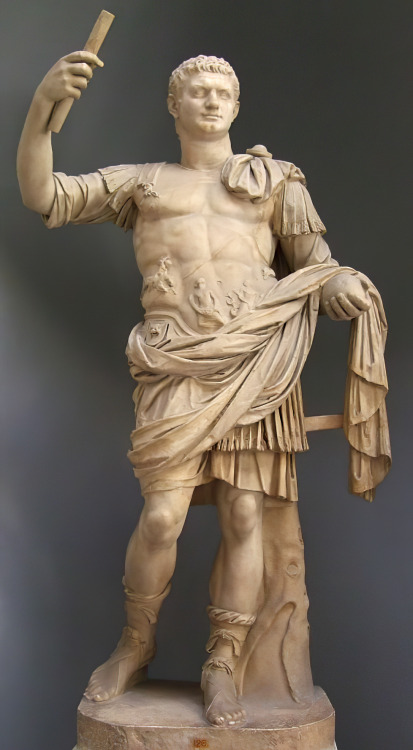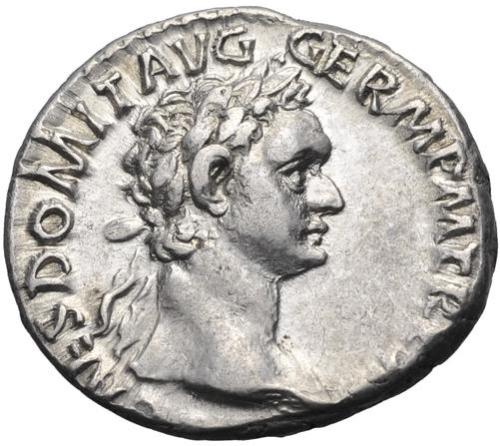#suetonius
On this day (14 September) in 81 A.D., Domitian became Roman Emperor. The last member of the Flavian dynasty, Domitian (Caesar Domitianus Augustus) was the second son of Emperor Vespasian and brother to the Emperor Titus, whom he succeeded when the latter died unexpectedly from a fever.
Prior to taking the imperial throne, Domitian had acted as a praetor (a judicial officer) and was appointed as consul on six separate occasions.
According to the Roman historian Suetonius, Domitian (as a young aristocrat) possessed a “lawless” streak that foreshadowed his reign, which would ultimately be remembered mainly for the Emperor’s cruelty and viciousness.
Suetonius however, also informs his readers that there were many positive aspects to Domitian’s rule. He “presented many extravagant entertainments in the Colosseum and the Circus… nor did he ever forget the Games given by the quaestors.” The Emperor also “founded a threefold festival of music,” dedicated to the Capitoline Jupiter. Domitian additionally embarked on a programme to restore some of Rome’s most important buildings, while adding to the city’s architecture with new construction projects. These ventures included, “a temple to Jupiter the Guardian on Capitoline Hill, the Forum of Nerva, the Flavian Temple, a stadium, a concert hall and [an] artificial lake for sea-battles.”
In the theatre of war, Domitian also led various campaigns: some that were perceived as justified and others, which were considered unnecessary. For instance, Suetonius calls the conflict against theChatti, “uncalled for” and the war against the Sarmatians, justified.
The Roman historian also claimed that “Domitian made a number of social innovations.” These included cancelling the public grain issue, banning castration and increasing the number of official chariot teams from four, to six.
Conversely, Domitian’s cruelty was infamous and well-reported. Suetonius divulges that “he executed [a] beardless boy, in distinctly poor health, merely because he happened to be a pupil of the actor Paris.” When the emperor disagreed with the writings of Hermogenes of Tarsus, the Greek rhetorician was executed and “the slaves who had acted as copyists were crucified.” Members of Roman civic society also lost their lives during Domitian’s reign of fear. Suetonius reveals that Civica Cerealis, Acilius Glabrio and Salvidienus Orfitus were “accused of conspiracy” and summarily executed. Aelius Lamia however, was killed because he voiced a sarcastic comment and Salvius Cocceianus “died because he continued to celebrate the birthday of the Roman Emperor Otho.”
Consequently, Domitian’s cruelty and autocracy earned him the disdain of the senate and he was assassinated on 18 September, 96 A.D.
References: Suetonius, The Twelve Caesars, trans. Robert Graves, revised with an introduction by Michael Grant, London: Penguin Books, 1979, pp. 303-319.
Images:Statue of Emperor Domitian, 1st Century A.D., marble, Vatican Museums, Vatican City, Rome. Wikimedia Commons.
Bust of Domitian, 1st Century A.D., marble, Musée du Louvre, Paris. Wikimedia Commons.
A Denarius of Domitian. Wikimedia Commons.
A Sestertius of Domitian. Wikimedia Commons.
Statue of the Roman Emperor Domitian, Vaison-la-Romaine, France. Wikimedia Commons.
Post link
The Death of Julius Caesar
C.L. Doughty (1913-85)
“… introiit curiam spreta religione Spurinnamque irridens et ut falsum arguens, quod sine ulla sua noxa Idus Martiae adessent: quanquam is uenisse quidem eas diceret, sed non praeterisse.
-
…he entered the senate-house, laughing at Spurinna as a false prophet, because the ides of March were come without any mischief having befallen him. To which the soothsayer replied, "They are come, indeed, but not past.” “
-Suetonius, Divus Iulius, 81.4
Oil On Canvas
Post link
reading ancient roman biographies of politicians is really great because you’ll have to slog through a whole bunch of informations about laws and reforms and then all of a sudden you hit a story about emperor tiberius being so paranoid that someone was trying to assassinate him that, when some poor dude tried to gift him with a massive fish, tiberius had the man beaten with both the fish and also a gigantic crab
Poor schmuck being forcibly exfoliated by fish scales: Well, it’s a good job I didn’t bring the giant crab or else I’d really be in -
Tiberius:Guards!
Schmuck:ohshit
Tiberius:Fetch the giant crab!
DOMUS AUGUSTI







Suetonius mentions the house of Augustus on the Palatine Hill several times. He underscores the size of the first emperor’s house:
- He lived … on the Palatine, but in the no less modest dwelling of Hortensius, which was remarkable neither for size nor elegance [ … sed nihilo minus aedibus modicis Hortensianis, et neque laxitate neque cultu conspicuis], having but short colonnades with columns of Alban stone and rooms without any marble decorations or handsome pavements. For more than forty years too he used the same bedroom in winter and summer …
He draws attention to an architectural anomaly and a distinctive feature of the house:
- He reared the temple of Apollo in that part of his house on the Palatine for which the soothsayers declared that the god had shown his desire by striking it with lightning. He joined to it colonnades with Latin and Greek libraries, and when he was getting to be an old man he often held meetings of the senate there as well.
- If ever he planned to do anything in private or without interruption, he had a retired place at the top of the house, which he called “Syracuse” and “technyphion.”
In compliance with traditional religion, Octavian erected a temple on the spot where lightning struck his property in 36 BC. To compensate him for his pious act and loss of real estate, the senate awarded him the public lands surrounding the temple. The temple flanked by libraries and colonnades enclosed a precinct is a precursor of the imperial Forum Augustus built decades later. The upper chamber, the so-called studiolo, survives; its mural and ceiling decoration clearly reflect the emperor’s taste.
For Suetonius, the house is an outward sign of the emperor’s political self-fashioning . Its modest size and the inconvenient temple attest to Augustus’ calculated observance of traditional standards of decorum and his public image of selfless service to the republic.
The mural decoration of the house is for the most part painted in a modified version of the Second Style of Pompeii. Compared to the contemporary frescos of Boscoreale or Oplontis, the architectural illusionism of the Palatine residence is less crowded with incident. The fictive columns, pilasters, capitals, and entablatures are gracefully attenuated and more generously spaced. The architecture often frames spaces devoid of imagery. Large expanses of the fictive wall treatments consist of minimally articulated expanses of opaque color. There are fewer vistas into implied spaces.

The quality of the illusionistic imagery more than compensates for the reduction of quantity. The precision and clarity of trompe l’œil details are astonishing, creating highly convincing illusions of three dimensionality. The exercises in perspectival rendering are much more rigorous and systematic than the more casual “fishbone” approach used in Campania. The confident execution of technically demanding passages, like the representation of lustre on metal surfaces in the unreflective medium of fresco attest to the skill of the artists.

above: Triclinium Fresco from the Villa of Agrippa Postumus at Boscotrecase, c. 20 BC, New York, Metropolitan Museum of Art.
The less-is-more aesthetic of the Domus Augusti fresco style surely reflects the understated personal taste of the patron. The decoration of the ceiling in the most private part of the house, the studiolo, is the clearest expression of that taste. The light and airy vinescrolls, elongated ornamental objects and high artificiality of the fresco and stucco ceiling decoration clearly strongly resembles the emergent Third Style. Exemplified by the fresco decoration of the Villa of Augustus’s righthand man Agrippa at Boscotrecase, the fictive architecture of the Third Style has been shorn of its illusionistic setting, transformed from a supporting to a framing structure, and its constituent members deployed in defiantly illogical, ungrounded configurations that violate the basic principles of classical architecture.

above: Studiolo ceiling decoration and Lower cubiculum fictive vault coffering, c. 20 BC, Rome, Domus Augusti.
Although less severely minimalistic, the studiolo ceiling breaks with tradition as cleanly as the Boscotrecase paintings. In the other, more public, parts of the house, however, the familar, veristic Second Style, is more or less maintained (the fictive vault coffering of the Lower Cubiculum could plausibly be described as First Style). Augustus was the master of having it both ways and the Domus Augusti mural cycle could be interpreted as another example of the de iure preservation and de facto disregard of tradition.






